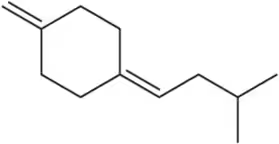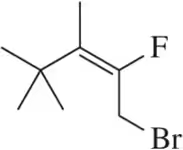 Back
Back Mullins 1st Edition
Mullins 1st Edition Ch. 11 - Properties and Synthesis of Alkyl Halides: Radical Reactions
Ch. 11 - Properties and Synthesis of Alkyl Halides: Radical ReactionsProblem 11.17
The most stable intermediate forms first. Explain this statement by showing a reaction coordinate diagram for the formation of a 3° carbocation over a 2° carbocation in the following alkene addition reaction.
Problem 12
Halohydrin formation is a stereospecific reaction. Identify the products of halohydrin formation of the following diastereomeric alkenes to demonstrate this stereospecificity.
Problem 14
Provide a mechanism for the chlorination of cyclohexane. Be sure to include initiation, propagation, and three possible termination steps.
Problem 15
A radical reaction, as it progressed through its propagation steps, involved the following radical species. Suggest which products might form in all possible termination steps (six products are possible).
Problem 16a
Based on the stability of the radicals produced, predict which bond in each pair would have the higher bond-dissociation energy.
(a)
Problem 16b
Based on the stability of the radicals produced, predict which bond in each pair would have the higher bond-dissociation energy.
(b)
Problem 16c
Based on the stability of the radicals produced, predict which bond in each pair would have the higher bond-dissociation energy.
(c)
Problem 16d
Based on the stability of the radicals produced, predict which bond in each pair would have the higher bond-dissociation energy.
(d)
Problem 18a
Using the bond-dissociation energies in Table 5.6,
(a) predict whether or not a fluorine radical would be selective for forming a single radical from propane.
Problem 18b
Using the bond-dissociation energies in Table 5.6,
(b) Will the transition state be reactant-like or product-like? Explain your answer.
Problem 19a
Using the bond-dissociation energies in Table 5.6,
(a) predict whether or not an iodine radical would be selective for forming a single radical propane.
Problem 20a
When (1R,3S)-1-tert-butyl-1,3-dimethylcyclopentane is halogenated, one stereoisomer is produced in excess.
(a) Predict the identity of the major stereoisomer
Problem 20b
When (1R,3S)-1-tert-butyl-1,3-dimethylcyclopentane is halogenated, one stereoisomer is produced in excess.
(b) explain why this reaction did not produce an equal mixture of stereoisomers.
Problem 21
Suppose a 2-halobutane was needed for a synthetic sequence. Starting your synthesis with butane, would it be best to put a chlorine or bromine at that position? Explain.
Problem 22b
Predict the major products of the following alkane halogenation reactions. [The number of products shown ignores the formation of racemic mixtures.]
(b)
Problem 22c
Predict the major products of the following alkane halogenation reactions. [The number of products shown ignores the formation of racemic mixtures.]
(c)
Problem 22d
Predict the major products of the following alkane halogenation reactions. [The number of products shown ignores the formation of racemic mixtures.]
(d)
Problem 23
Can you make a 1° bromoalkane like (3-bromopropyl)cyclopentane using alkane halogenation? Why or why not?
Problem 24a
Why is a 2° carbon radical more stable than a 1° carbon radical?
Problem 25a
Predict the major products of the following alkene halogenation reactions. [D is the symbol for deuterium, an isotope of hydrogen.]
(a)
Problem 25b
Predict the major products of the following alkene halogenation reactions. [D is the symbol for deuterium, an isotope of hydrogen.]
(b)
Problem 26
HBr and peroxides are also used to generate 1-bromo-1-alkenes. Suggest a starting reactant that would successfully undergo this reaction.
Problem 27a
Identify the allylic carbon(s) in the following molecules.
(a)
Problem 27b
Identify the allylic carbon(s) in the following molecules.
(b)
Problem 27c
Identify the allylic carbon(s) in the following molecules.
(c)
Problem 28
We show in Chapter 12 that C― Br bonds can break to give a carbocation and a bromide anion. For which of the organohalides (A or B) would you expect this process to be fastest? Explain.
Problem 29
In the following reaction, which C―H bond would be most likely to react with a bromine radical?
Problem 30c
In the following molecules, identify the carbon where the radical is most likely to form in the first propagation step.
(c)
Problem 30d
In the following molecules, identify the carbon where the radical is most likely to form in the first propagation step.
(d)
Problem 31a
In the following allylic radicals, identify the carbon where the new C–Br bond is most likely to form in the second propagation step.
(a)

























